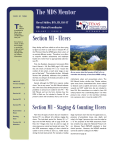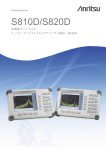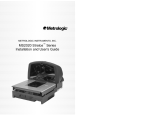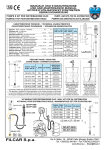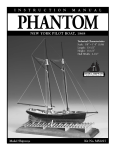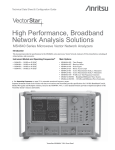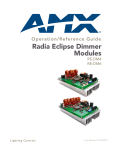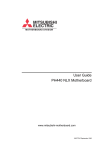Download Anritsu MS2038C User's Manual
Transcript
Technical Data Sheet VNA Master ™ Handheld Vector Network Analyzer + Spectrum Analyzer MS2026C MS2036C MS2028C MS2038C 5 kHz to 6 GHz 5 kHz to 6 GHz 5 kHz to 20 GHz 5 kHz to 20 GHz Vector Network Analyzer 9 kHz to 9 GHz 9 kHz to 20 GHz + Spectrum Analyzer The Ultimate Handheld Vector Network + Spectrum Analyzer for Cable, Antenna and Signal Analysis Anytime, Anywhere Introduction High Performance Handheld S-Parameters Anritsu introduces the MS202x/3xC VNA Master + Spectrum Analyzer, the industry’s broadest frequency handheld solution to address cable, antenna, component and signal analysis needs in the field: with frequency coverage from 5 kHz to 6/20 GHz. Equally impressive, this broadband measurement tool offers the industry’s first 12-term error correction algorithm in a truly handheld, battery-operated, rugged multi-function instrument. And now the MS2036/38C models include a powerful spectrum analyzer which multiplies user convenience by combining spectrum analysis with the VNA into a single measurement powerhouse for the harsh RF and physical environments of field test. Whether it is for spectrum monitoring, broadcast proofing, interference analysis, RF and microwave measurements, regulatory compliance, or 3G/4G and wireless data network measurements, this VNA/Spectrum Analyzer marriage is the ideal instrument to making fast and reliable measurements in the field. Performance and Functional Highlights VNA Master • Broadband coverage of 5 kHz to 6/20 GHz • True 2-port Vector Network Analyzer (VNA) • Ultimate accuracy with 12-term error correction • User-defined quad display for viewing all 4 S-Parameters • Arbitrary data points up to 4001 • IF Bandwidth selections of 10 Hz to 100 kHz • 85 dB dynamic range to 20 GHz • Supports waveguide measurements • 350 µs/data point sweep speed • USB/Ethernet for PC data transfer and control • Automate repetitive tasks via Ethernet & USB • Field upgradable firmware • Store more than 4000 traces and setups in memory • Portable: 10.5 lbs (4.8 kg) • Full Speed USB Memory support • High resolution daylight viewable TFT color display • Time Domain option for Distance-to-Fault diagnostics • Internal Bias Tee option • Vector Voltmeter option • High Accuracy Power Meter option • Differential option (Sd1d1, Sc1c1, Sd1c1, and Sc1d1) • Secure Data Operation option • GPS Receiver option • Power Monitor option • Polar Format Impedance Display • 4, 6, 8, 18, 26 GHz USB Power Sensors • 8.4 in. Display VNA Master + Spectrum Analyzer All of the above VNA features PLUS: • Measure: Occupied Bandwidth, Channel Power, ACPR, C/I • Dynamic Range: > 104 dB in 1 Hz RBW • DANL: –160 dBm in 1 Hz RBW • Phase Noise: –100 dBc/Hz @ 10 kHz offset at 1 GHz • Frequency Accuracy: < ± 25 ppb with GPS On • 1 Hz to 10 MHz Resolution Bandwidth (RBW) • Traces: Normal, Max Hold, Min Hold, Average, # of Averages • Detectors: Peak, Negative, Sample, Quasi-peak, and true RMS • Markers: 6, each with a Delta Marker, or 1 Reference with 6 Deltas • Limit Lines: up to 40 segments with one-button envelope creation • Trace Save-on-Event: crossing limit line or sweep complete • Option to automatically optimize sweep-RBW-VBW tradeoff for best possible display • Interference Analyzer Option: Spectrogram, Signal Strength, RSSI • Channel Scanner Option • Zero-span IF Output • Gated Sweep • GPS tagging of stored traces • Internal Preamplifier standard • High Accuracy Power Meter Option • AM/FM/SSB Demodulation (audio only) VNA Master Functional Specifications Definitions • All specifications and characteristics apply under the following conditions, unless otherwise stated: • After 30 minutes of warm-up time, where the instrument is in VNA Mode and left in the ON state. • Temperature range is 23 ºC ± 5 ºC. • All specifications apply when using internal reference. • All specifications subject to change without notice. Please visit www.us.anritsu.com for most current data sheet. • Typical performance is the measured performance of an average unit. • Recommended calibration cycle is 12 months. Frequency VNA Master Frequency Range: Frequency Accuracy: Frequency Resolution: MS2026/36C: 5 kHz to 6 GHz MS2028/38C: 5 kHz to 20 GHz 1.5 ppm 1 Hz to 375 MHz, 10 Hz to 6 GHz, and 100 Hz to 20 GHz Typical Test Port Power Block Diagram VNA Master supports selection of either High (default) or Low test port power. Changing power after calibration can degrade the calibrated performance. Typical power by bands is shown in the following table. As shown in the following block diagram, the VNA Master has a 2-port, 2-path architecture that automatically measures four S-parameters with a single connection. Frequency Range High Port Power (dB) Low Port Power (dBm) 5 kHz to ≤ 3 GHz +3 –25 3 GHz to ≤ 6 GHz –3 –25 6 GHz to ≤ 20 GHz –3 –15 Port 1 S11 Port 2 DUT S22 S12 Receiver Port 1 Transmission Dynamic Range The transmission dynamic range (the difference between test port power and noise floor) using 10 Hz IF Bandwidth and High Port Power is shown in the following table. Frequency Range S21 Bridge/ Coupler Receiver Port 2 Reference Receiver Bridge/ Coupler Dynamic Range (dB) 5 kHz to ≤ 2 MHz 85 2 MHz to ≤ 3 GHz 100 3 GHz to ≤ 6 GHz 90 6 GHz to ≤ 20 GHz 85 Source Switch The above illustration is a simplified block diagram of VNA Master’s 2-port, 2-path architecture. Typical Sweep Speed The typical sweep speed for IF Bandwidth of 100 kHz, 1001 data points, and single display is shown in the following table. The three receiver architecture will simultaneously collect S21 and S11 (or S12 and S22 ) in a single sweep. Frequency Range Typical Sweep Speed (µs/point) 5 kHz to 6 GHz 350 6 GHz to 20 GHz 650 Uncertainty Curves for Round-Trip Cable Loss Measurements (1-Port) Round-trip cable loss measurements are convenient for field personnel testing installed cable or waveguide runs. This one-port technique provides one-way data after twice traversing the cable. The following two sets of uncertainty curves, less than 6 GHz on the left and greater than 6 GHz on the right, present worst-case uncertainty by DUT Match (i.e., Log Mag) when using VNA Master for one-port cable loss measurements. As a practical tip, consider using a two-port transmission measurement technique to improve upon these one-port cable loss uncertainties. VNA Master (MS20xxC), 5 kHz - 6 GHz One Port Cable Loss (Log Mag / 2) Uncertainty vs. DUT Match VNA Master (MS20xxC), 6 - 20 GHz One Port Cable Loss (Log Mag / 2) Uncertainty vs. DUT Match 10 Uncertainty (dB) Uncertainty (dB) 10 -20 dB 1 -25 dB -30 dB 0.1 -20 dB 1 -25 dB -30 dB 0.1 0 1 2 3 4 5 6 7 8 9 10 0 Cable Loss, Log Mag / 2 (dB) 1 2 3 4 5 6 7 8 9 Cable Loss, Log Mag / 2 (dB) These uncertainty curves show how frequency range, DUT Match, and cable loss impact worst-case uncertainty of round-trip cable loss measurements. The uncertainty curves, separated by frequency range, are shown for DUT Match conditions of 20, 25, and 30 dB. For DUT Match of 30 dB and cable loss of 4-5 dB (reflection measurement of 8-10 dB) the worst-case uncertainties are approximately ±1 dB. 10 High Port Power OSLxx50 Calibration Components (N-Connectors) Corrected System Performance and Uncertainties: MS202x/3xC Model with 12-term SOLT calibration including isolation using either OSLN50 & OSLNF50 or OSLK50 & OSLKF50 Calibration Kits Precision calibration standards come in a convenient configuration for field work. Frequency Range (GHz) Directivity (dB) Frequency Range (GHz) Typical High Port Power (dBm) ≤5 > 42 ≤3 +3 ≤ 15 > 36 ≤6 –3 ≤ 20* > 32 ≤ 20 –3 * N Connector guaranteed to 18 GHz, typical > 18 GHz Measurement Uncertainties The following graphs provide measurement uncertainty at 23 ºC ± 5 ºC for the above indicated connector type and calibration. Errors are worse-case contributions of residual directivity, source match, frequency response, network analyzer dynamic range, and connector repeatability. For two-port measurements, transmission tracking, crosstalk, and physical load match termination were added. Isolation calibration and an IF Bandwidth of 10 Hz is used. S21 Magnitude S11 Magnitude 10 10 Uncertainty 0.5 MHz to 20 MHz Uncertainty 0.5 MHz to 20 MHz Uncertainty 20 MHz to 3 GHz Uncertainty 20 MHz to 3 GHz Uncertainty 3 GHz to 6 GHz Uncertainty 3 GHz to 6 GHz Uncertainty 6 GHz to 20 GHz Uncertainty 6 GHz to 20 GHz 1 1 0.1 0.1 0.01 -40 -35 -30 -25 -20 -15 -10 -5 -80 0 -70 -60 -50 -40 -30 -20 -10 0 S21 Phase S11 Phase 100 100 Uncertainty 0.5 MHz to 20 MHz Uncertainty 0.5 MHz to 20 MHz Uncertainty 20 MHz to 3 GHz Uncertainty 20 MHz to 3 GHz Uncertainty 3 GHz to 6 GHz Uncertainty 3 GHz to 6 GHz Uncertainty 6 GHz to 20 GHz Uncertainty 6 GHz to 20 GHz 10 10 1 1 -40 0.1 -35 -30 -25 -20 -15 -10 -5 0 -80 -70 -60 -50 -40 -30 -20 -10 0 Low Port Power OSLxx50 Calibration Components Corrected System Performance and Uncertainties: MS202x/3xC Model with 12-term SOLT calibration including isolation using either OSLN50 & OSLNF50 or OSLK50 & OSLKF50 Calibration Kits Frequency Range (GHz) Directivity (dB) Frequency Range (GHz) Typical High Port Power (dBm) ≤5 > 42 ≤3 –25 ≤ 15 > 36 ≤6 –25 ≤ 20* > 32 ≤ 20 –15 * N Connector guaranteed to 18 GHz, typical > 18 GHz Measurement Uncertainties The following graphs provide measurement uncertainty at 23 ºC ± 5 ºC for the above indicated connector type and calibration. Errors are worse-case contributions of residual directivity, source match, frequency response, network analyzer dynamic range, and connector repeatability. For two-port measurements, transmission tracking, crosstalk, and physical load match termination were added. Isolation calibration and an IF Bandwidth of 10 Hz is used. S21 Magnitude S11 Magnitude 10 10 Uncertainty 0.5 MHz to 20 MHz Uncertainty 0.5 MHz to 20 MHz Uncertainty 20 MHz to 3 GHz Uncertainty 20 MHz to 3 GHz Uncertainty 3 GHz to 6 GHz Uncertainty 3 GHz to 6 GHz Uncertainty 6 GHz to 20 GHz Uncertainty 6 GHz to 20 GHz 1 1 0.11 0.1 0.01 -40 -35 -30 -25 -20 -15 -10 -5 -80 0 -70 -60 -50 -40 -30 -20 -10 0 S21 Phase S11 Phase 100 100 Uncertainty 0.5 MHz to 20 MHz Uncertainty 0.5 MHz to 20 MHz Uncertainty 20 MHz to 3 GHz Uncertainty 20 MHz to 3 GHz Uncertainty 3 GHz to 6 GHz Uncertainty 3 GHz to 6 GHz Uncertainty 6 GHz to 20 GHz Uncertainty 6 GHz to 20 GHz 10 10 1 1 -40 0.1 -35 -30 -25 -20 -15 -10 -5 0 -80 -70 -60 -50 -40 -30 -20 -10 0 High Port Power 3652A Calibration Kit (K-Connector) Corrected System Performance and Uncertainties: MS202x/3xC Model with 12-term SOLT calibration including isolation using 3652A Calibration Kit Frequency Range (GHz) Directivity (dB) Frequency Range (GHz) Typical High Port Power (dBm) ≤5 > 42 ≤3 +3 ≤ 15 > 36 ≤6 –3 ≤ 20* > 32 ≤ 20 –3 * N Connector guaranteed to 18 GHz, typical > 18 GHz Measurement Uncertainties The following graphs provide measurement uncertainty at 23 ºC ± 5 ºC for the above indicated connector type and calibration. Errors are worse-case contributions of residual directivity, source match, frequency response, network analyzer dynamic range, and connector repeatability. For two-port measurements, transmission tracking, crosstalk, and physical load match termination were added. Isolation calibration and an IF Bandwidth of 10 Hz is used. S21 Magnitude S11 Magnitude 10 10 Uncertainty 0.5 MHz to 20 MHz Uncertainty 0.5 MHz to 20 MHz Uncertainty 20 MHz to 3 GHz Uncertainty 20 MHz to 3 GHz Uncertainty 3 GHz to 6 GHz Uncertainty 3 GHz to 6 GHz Uncertainty 6 GHz to 20 GHz Uncertainty 6 GHz to 20 GHz 1 1 0.1 0.01 0.1 -40 -35 -30 -25 -20 -15 -10 -5 -80 0 -70 -60 -50 -30 -20 -10 0 S21 Phase S11 Phase 100 100 Uncertainty 0.5 MHz to 20 MHz Uncertainty 0.5 MHz to 20 MHz Uncertainty 20 MHz to 3 GHz Uncertainty 20 MHz to 3 GHz Uncertainty 3 GHz to 6 GHz Uncertainty 3 GHz to 6 GHz Uncertainty 6 GHz to 20 GHz Uncertainty 6 GHz to 20 GHz 10 10 1 1 0.1 -40 -40 0.1 -35 -30 -25 -20 -15 -10 -5 0 -80 -70 -60 -50 -40 -30 -20 -10 0 Low Port Power 3652A Calibration Kit (K-Connector) Corrected System Performance and Uncertainties: MS202x/3xC Model with 12-term SOLT calibration including isolation using 3652A Calibration Kit Frequency Range (GHz) Directivity (dB) Frequency Range (GHz) Typical Low Port Power (dBm) ≤5 > 42 ≤3 –25 ≤ 15 > 36 ≤6 –25 ≤ 20* > 32 ≤ 20 –25 * N Connector guaranteed to 18 GHz, typical > 18 GHz Measurement Uncertainties The following graphs provide measurement uncertainty at 23 ºC ± 5 ºC for the above indicated connector type and calibration. Errors are worse-case contributions of residual directivity, source match, frequency response, network analyzer dynamic range, and connector repeatability. For two-port measurements, transmission tracking, crosstalk, and physical load match termination were added. Isolation calibration and an IF Bandwidth of 10 Hz is used. S21 Magnitude S11 Magnitude 10 10 Uncertainty 0.5 MHz to 20 MHz Uncertainty 0.5 MHz to 20 MHz Uncertainty 20 MHz to 3 GHz Uncertainty 20 MHz to 3 GHz Uncertainty 3 GHz to 6 GHz Uncertainty 3 GHz to 6 GHz Uncertainty 6 GHz to 20 GHz Uncertainty 6 GHz to 20 GHz 1 1 0.1 0.1 0.01 -40 -35 -30 -25 -20 -15 -10 -5 -80 0 -70 -60 -50 -30 -20 -10 0 S21 Phase S11 Phase 100 100 Uncertainty 0.5 MHz to 20 MHz Uncertainty 0.5 MHz to 20 MHz Uncertainty 20 MHz to 3 GHz Uncertainty 20 MHz to 3 GHz Uncertainty 3 GHz to 6 GHz Uncertainty 3 GHz to 6 GHz Uncertainty 6 GHz to 20 GHz Uncertainty 6 GHz to 20 GHz 10 10 1 1 0.1 -40 -40 0.1 -35 -30 -25 -20 -15 -10 -5 0 -80 -70 -60 -50 -40 -30 -20 -10 0 + Spectrum Analyzer Functional Specifications (Models MS2036/38C only) Frequency Frequency Range 9 kHz to 20 GHz (usable to 0 Hz), Preamp 100 kHz to 20 GHz Tuning Resolution 1 Hz Frequency Reference Aging: ± 1.0 ppm/10 years Accuracy: ± 0.3 ppm (25 °C ± 25 °C) + aging External Reference Frequencies 1, 1.2288, 1.544, 2.048, 2.4576, 4.8, 4.9152, 5, 9.8304, 10, 13, 19.6608 MHz Frequency Span 10 Hz to 20 GHz including zero span Sweep Time 10 μs to 600 seconds in zero span Sweep Time Accuracy ± 2% in zero span Bandwidth Resolution Bandwidth (RBW) 1 Hz to 10 MHz in 1–3 sequence ± 10% (–3 dB bandwidth) Video Bandwidth (VBW) 1 Hz to 10 MHz in 1–3 sequence (–3 dB bandwidth) RBW with Quasi-Peak Detection 200 Hz, 9 KHz, 120 kHz (–6 dB bandwidth) VBW with Quasi-Peak Detection Auto VBW is On, RBW/VBW = 1 Spectral Purity SSB Phase Noise at 1 GHz –100 dBc/Hz @ 10 kHz offset from carrier (–104 dBc/Hz typical) –102 dBc/Hz @ 100 kHz offset from carrier (–107 dBc/Hz typical) –107 dBc/Hz @ 1 MHz offset from carrier (–114 dBc/Hz typical) –120 dBc/Hz @ 10 MHz offset from carrier (–129 dBc/Hz typical) Amplitude Ranges Dynamic Range > 104 dB @ 2.4 GHz, 2/3 (TOI-DANL) in 1 Hz RBW Measurement Range DANL to +30 dBm Display Range 1 to 15 dB/div in 1 dB steps, ten divisions displayed Reference Level Range –120 dBm to +30 dBm Attenuator Resolution 0 to 65 dB, 5 dB steps Amplitude Units Log Scale Modes: dBm, dBV, dBmv, dBμVLinear Scale Modes: nV, μV, mV, V, kV, nW, μW, mW, W, kW Maximum Continuous Input +30 dBm Peak, ± 50 VDC (≥ 10 dB Attn) +23 dBm Peak, ± 50 VDC (< 10 dB Attn) +13 dBm Peak, ± 50 VDC (Preamp On) Amplitude Accuracy (single sine wave input < Ref level, and > DANL, auto attenuation) 20 °C to 30 °C after 30 minute warm-up Typical: ± 0.5 dB, 100 kHz to 20 GHz Maximum: ± 1.3 dB, 100 kHz to 13 GHz Add ± 1.0 dB, 13 GHz to 20 GHz –10 °C to 50 °C after 60 minute warm-up Add ± 1.0 dB, 100 kHz to 20 GHz Displayed Average Noise Level (DANL) (RMS detection, VBW/Avg type = Log., Ref Level = –20 dBm for preamp Off and –50 dBm for preamp On) (DANL in 1 Hz RBW, 0 dB attenuation) Preamp Off 10 MHz to 4 GHz –141 dBm > 4 GHz to 9 GHz –134 dBm > 9 GHz to 13 GHz –129 dBm > 13 GHz to 20 GHz –123 dBm (MS2038C only) Preamp On 10 MHz to 4 GHz –160 dBm > 4 GHz to 9 GHz –156 dBm > 9 GHz to 13 GHz –152 dBm > 13 GHz to 20 GHz –145 dBm + Spectrum Analyzer Functional Specifications (Models MS2036/38C only) (continued) Spurs Residual Spurious Input-Related Spurious Preamp Off (RF input terminated, 0 dB input attenuation) –90 dBm 9 kHz to 13 GHz –85 dBm 13 GHz to 20 GHz Preamp On (RF input terminated, 0 dB input attenuation) –100 dBm 1 MHz to 20 GHz (0 dB attenuation, –30 dBm input, span < 1.7 GHz) –60 dBc, –70 dBc typical Third-Order Intercept (TOI) (–20 dBm tones 100 kHz apart, –20 dBm Ref level, 0 dB input attenuation, preamp Off) 2.4 GHz +15 dBm 50 MHz to 20 GHz +20 dBm typical P1dB < 4 GHz +5 dBm typical 4 GHz to 20 GHz +12 dBm typical Second Harmonic Distortion 50 MHz –54 dBc < 4 GHz –60 dBc typical > 4 GHz –75 dBc typical VSWR > 10 dB input attenuation < 20 GHz 1:5:1 typical 10 VNA Performance Capabilities (MS202x/3xC) Measurement Parameters S11, S21, S22, S12, Sd1d1, Sc1c1, Sd1c1, Sc1d1 Number of Traces Four: TR1, TR2, TR3, TR4 Trace Format Single, Dual, Tri, Quad. When used with Number of Traces, overlays are possible including a Single Format with Four trace overlays. Graph Types Log Magnitude SWR Phase Real Imaginary Group Delay Smith Chart Log Mag / 2 (1-Port Cable Loss) Linear Polar Log Polar Real Impedance Imaginary Impedance Domains Frequency Domain, Time Domain, Distance Domain Frequency Start Frequency, Stop Frequency, Center Frequency, Span Distance Start Distance, Stop Distance Time Start Time, Stop Time Frequency Sweep Type: Linear Single Sweep, Continuous Data Points 2 to 4001 (arbitrary setting); data points can be reduced without recalibration. Limit Lines Upper, Lower, 10 segmented Upper, 10 segmented Lower Test Limits Pass/Fail for Upper, Pass/Fail for Lower, Limit Audible Alarm Data Averaging Sweep-by-sweep Smoothing 0 to 20% IF Bandwidth 10, 30, 100, 300, 1k, 3k, 10k, 30k, 100k (Hz) Reference Plane The reference planes of a calibration (or other normalization) can be changed by entering a line length. Assumes no loss, flat magnitude, linear phase, and constant impedance. Auto Reference Plane Extension Instead of manually entering a line length, this feature automatically adjusts phase shift from the current calibration (or other normalization) to compensate for external cables (or test fixtures). Assumes no loss, flat magnitude, linear phase, and constant impedance. Frequency Range Frequency range of the measurement can be narrowed within the calibration range without recalibration. Group Delay Aperture Defined as the frequency span over which the phase change is computed at a given frequency point. The aperture can be changed without recalibration. The minimum aperture is the frequency range divided by the number of points in calibration and can be increased to 20% of the frequency range. Group Delay Range < 180º of phase change within the aperture Trace Memory A separate memory for each trace can be used to store measurement data for later display. The trace data can be saved and recalled. Trace Math Complex trace math operations of subtraction, addition, multiplication, or division are provided. Number of Markers Eight, arbitrary assignments to any trace Marker Types Reference, Delta Marker Readout Styles Log Mag, Cable Loss (Log Mag / 2), Log Mag and Phase, Phase, Real and Imaginary, SWR, Impedance, Admittance, Normalized Impedance, Normalized Admittance, Polar Impedance, and Group Delay, Linear Mag, Linear Mag and Phase Marker Search Peak Search, Valley Search, Find Marker Value Correction Models Full 2-Port, Full S11, Full S22, Full S11 & S22, Response S21, Response S12, Response S21 & S12, Response S11, Response S22, Response S11 & S22, One-Path Two-Port (S11,S21), One-Path Two-Port (S22,S12) Calibration Methods Short-Open-Load-Through (SOLT), Offset-Short (SSLT), and Triple-Offset-Short (SSST) Calibration Standards’ Coefficients Coax: N-Connector, K-Connector, 7/16, TNC, SMA, and four User Defined Waveguide: WG11A, WG12, WG13, WG14, WG15, WG16, WG17, WG18, WG20, and four User Defined Cal Correction Toggle On/Off Dispersion Compensation Waveguide correction that improves accuracy of distance-to-fault data by compensating for different wavelengths propagating at different speeds. Impedance Conversion Support for 50 Ω and 75 Ω are provided. Units Meters, Feet Bias Tee Settings Internal, External, Off Timebase Reference Internal, External (10 MHz) File Storage Types Measurement, Setup (with CAL), Setup (without CAL), S2P (Real/Imag), S2P (Lin Mag/Phase), S2P (Log Mag/Phase), JPEG Ethernet Configuration DHCP or Manual (Static); IP, Gateway, Subnet entries Languages English, French, German, Spanish, Chinese, Japanese, Korean, Italian, plus two User Defined 11 + Spectrum Analyzer Performance Capabilities Measurements Smart Measurements Field Strength (uses antenna calibration tables to measure dBm/m2 or dBmV/m) Occupied Bandwidth (measures 99% to 1% power channel of a signal) Channel Power (measures the total power in a specified bandwidth) ACPR (adjacent channel power ratio) C/I (carrier-to-interference ratio) Emission Mask (recall limit lines as emission mask) Setup Parameters Frequency Center/Start/Stop, Span, Frequency Step, Signal Standard, Channel # Amplitude Reference Level (RL), Scale, Attenuation Auto/Level, RL Offset, Pre-Amp On/Off, Detection Span Span, Span Up/Down (1-2-5), Full Span, Zero Span, Last Span Bandwidth RBW, Auto RBW, VBW, Auto VBW, RBW/VBW, Span/RBW File Save, Recall, Delete, Directory Management Save/Recall Setups, Measurements, Limit Lines, Screen Shots Jpeg (save only), Save-on-Event Save-on-Event Crossing Limit Line, Sweep Complete, Save-then-Stop, Clear All Delete Selected File, All Measurements, All Mode Files, All Content Directory Management Sort Method (Name/Type/Date), Ascend/Descend, Internal/USB, Copy Application Options Impedance (50 Ω, 75 Ω, Other) Sweep Functions Sweep Single/Continuous, Manual Trigger, Reset, Detection, Minimum Sweep Time, Trigger Type Sweep Mode Fast, Performance, No FFT Detection Peak, RMS/Avg, Negative, Sample, Quasi-peak Triggers Free Run, External, Video, Delay, Level, Slope, Hysteresis, Holdoff, Force Trigger Once Trace Functions Traces Up to three Traces (A, B, C), View/Blank, Write/Hold, Trace A/B/C Operations Trace A Operations Normal, Max Hold, Min Hold, Average, # of Averages, (always the live trace) Trace B Operations A→B, B↔C, Max Hold, Min Hold Trace C Operations A→C, B↔C, Max Hold, Min Hold, A – B→C, B – A→C, Relative Reference (dB), Scale Marker Functions Markers Markers 1-6 each with a Delta Marker, or Marker 1 Reference with Six Delta Markers, Marker Table (On/Off/Large), All Markers Off Marker Types Style (Fixed/Tracking), Noise Marker, Frequency Counter Marker Marker Auto-Position Peak Search, Next Peak (Right/Left), Peak Threshold %, Set Marker to Channel, Marker Frequency to Center, Delta Marker to Span, Marker to Reference Level Marker Table 1-6 markers frequency and amplitude plus delta markers frequency offset and amplitude Limit Line Functions Limit Lines Upper/Lower, On/Off, Edit, Move, Envelope, Advanced, Limit Alarm, Default Limit Limit Line Edit Frequency, Amplitude, Add Point, Add Vertical, Delete Point, Next Point Left/Right Limit Line Move To Current Center Frequency, By dB or Hz, To Marker 1, Offset from Marker 1 Limit Line Envelope Create Envelope, Update Amplitude, Number of Points (41), Offset, Shape Square/Slope Limit Line Advanced Type (Absolute/Relative), Mirror, Save/Recall 12 Measurement Options Specifications Time Domain (Option 0002) (includes Distance Domain Option 0501) The VNA Master can also display the S-parameter measurements in the time or distance domain using lowpass or bandpass processing analysis modes. The broadband frequency coverage coupled with 4001 data points means you can measure discontinuities both near and far with unprecedented clarity for a handheld tool. With this option, you can simultaneously view S-parameters in frequency, time, and distance domain to quickly identify faults in the field. Advanced features available with this option include step response, phasor impulse, gating, and frequency gated in time. The option includes computational routines that further enhance the Distance Domain results by compensating for cable loss, relative velocity of propagation, and dispersion compensation in waveguide. Distance Domain Round-Trip (reflection) Fault Resolution (meters): (0.5 x c x Vp) / ∆F; (c is speed of light = 3E8 m/s, ∆F is F2 – F1 in Hz) One-Way (transmission) Fault Resolution (meters): (c x Vp) / ∆F; (c is speed of light = 3E8 m/s, ∆F is F2 – F1 in Hz) Horizontal Range (meters): 0 to (data points – 1) x Fault Resolution to a maximum of 3000 m (9843 ft.) Windowing Rectangular, Nominal Side Lobe (NSL), Low Side Lobe (LSL), and Minimum Side Lobe (MSL) Power Monitor (Option 0005) Requires external detector Transmitter measurements in the field are possible when using this VNA Master software mode with a separately purchased Anritsu 560 series detector. A variety of detectors are available to 50 GHz, but the popular 560-7N50B covers 10 MHz to 20 GHz with a measurement range of –50 to +20 dBm with better than 0.5 dB flatness to 18 GHz. After zeroing the detector to ensure accuracy at low power levels, the software offers intuitive operation for absolute and relative readouts in dBm or Watts. Display Range –80 to +80 dBm (10 pW to 100 kW) Measurement Range –50 to +20 dBm (10 nW to 40 mW) Offset Range 0 to +60 dB Resolution 0.1 dB, 0.1 xW (x = n, µ, m based on detector power) Accuracy ±1 dB maximum for >–40 dBm using 560-7N50B detector Power Monitor Detectors* (Ordered separately): Part Numbers 560-7N50B 560-7S50B Frequency Range 0.01 to 20 GHz 0.01 to 20 GHz Impedance 50 Ω 50 Ω Power Range –55 dBm to +16 dBm –55 dBm to +16 dBm Return Loss 15 dB, < 0.04 GHz 22 dB, < 8 GHz 17 dB, < 18 GHz 14 dB, < 20 GHz 15 dB, < 0.04 GHz 22 dB, < 8 GHz 17 dB, < 18 GHz 14 dB, < 20 GHz Input Connector N(m) WSMA(m) Frequency Response ±0.5 dB, < 18 GHz ±1.25 dB, < 20 GHz ±0.5 dB, < 18 GHz ±1.25 dB, < 20 GHz *See www.us.anritsu.com for additional detectors Secure Data Operation (Option 0007) For highly secure data handling requirements, this software option prevents the storing of measurement setup or data information onto any internal file storage location. Instead, setup and measurement information is stored ONLY to the external USB memory location. A simple factory preset prepares the VNA Master for transportation while the USB memory remains behind in the secure environment. The VNA Master cannot be switched between secure and non-secure operation by the user once configured for secure data operation. As an additional security measure, with this option enabled the user can choose to blank the frequency values displayed on the screen. 13 Bias Tee (Option 0010) Vector Voltmeter (Option 0015) For tower mounted amplifier tests, the MS20x/3xC series with optional internal bias tees can supply both DC and RF signals on the center conductor of the cable during measurements. For frequency sweeps in excess of 2 MHz, the VNA Master can supply internal voltage control from +12 to +32 V in 0.1 V steps up to 450 mA. To extend battery life, an external power supply can substitute for the internal supply by using the external bias inputs instead. Both test ports can be configured to supply voltage via this integrated bias tees option. Bias can be directed to VNA Port 1 or Port 2. A phased array system relies on phase matched cables for nominal performance. For this class of application, the VNA Master offers this special software mode to simplify phase matching cables at a single frequency. The similarity between the popular vector voltmeter and this software mode ensures minimal training is required to phase match cables. Operation is as simple as configuring the display for absolute or relative measurements. The easy-to-read large fonts show either reflection or transmission measurements using impedance, magnitude, or VSWR readouts. For instrument landing system (ILS) or VHF Omni-directional Range (VOR) applications, a table view improves operator efficiency when phase matching up to twelve cables. The MS202x/3xC solution is superior because the signal source is included internally, precluding the need for an external signal generator. Frequency Range 2 MHz to 6 GHz (MS20x6C) 2 MHz to 20 GHz (MS20x8C) Internal Voltage/Current +12V to +32V at 450 ma. Steady rate Internal Resolution 0.1V External Voltage/Current ±50 V at 500 mA steady rate CW Frequency Range 5 kHz to 20 GHz Bias Tee Selections Internal, External, Off Measurement Display CW, Table (Twelve Entries, Plus Reference) Measurement Types Return Loss, Insertion Measurement Format dB/VSWR/Impedance Port 1 Port 2 External Bias Input (±50 V, 500 mA Max) Internal Bias Tee Switch Internal Bias Tee Internal Bias +12 to +32 V 450 mA Max RF Test Source Switch The VNA Master offers optional integrated bias tee for supplying DC plus RF to the DUT as shown in this simplified block diagram. Connectivity is also provided for external supply (instead of internal) to preserve battery consumption. 14 High Accuracy Power Meter (Option 0019) Requires external USB power sensor. Conduct precise measurements of CW and digitally modulated transmitters in the field using this VNA Master software mode with a separately purchased Anritsu USB power sensor. After specifying the center frequency and zeroing the sensor to ensure accuracy at low power levels, the software offers intuitive operation for absolute and relative readouts in dBm or Watts. Option 0019 supports the USB Power Sensors in the following table. USB Power Sensors (Ordered separately): PSN50 MA24104A MA24106A MA24108A MA24118A Frequency Range 50 MHz to 6 GHz 600 MHz to 4 GHz 50 MHz to 6 GHz 10 MHz to 8 GHz 10 MHz to 18 GHz Description High Accuracy RF Power Sensor Inline High Power Sensor High Accuracy RF Power Sensor Microwave USB Power Sensor Microwave USB Power Sensor Connector Type N, male, 50 Ω Type N, female, Ω Type N, male, 50 Ω Type N, male, 50 Ω Type N, male, 50 Ω Dynamic Range –30 dBm to +20 dBm (0.001 mW to 100 mW) +3 dBm to +51.76 dBm (2 mW to 150 W) –40 dBm to +23 dBm (0.1 µW to 200 mW) –40 dBm to +20 dBm (0.1 µW to 100 mW) –40 dBm to +20 dBm (0.1 µW to 100 mW) VBW 100 Hz 100 Hz 100 Hz 50 kHz 50 kHz Measurement True-RMS True-RMS True-RMS True-RMS. Slot Power, Burst Average Power True-RMS, Slot power, Burst Average power Measurement Uncertainty ±0.16 dB1 ±0.17 dB2 ±0.16 dB1 ±0.18 dB3 ±0.18 dB3 Datasheet for Additional Specifications 11410-00414 11410-00483 11410-00424 11410-00504 11410-00504 Notes: 1) Total RSS measurement uncertainty (0 ºC to 50 ºC) for power measurements of a CW signal greater than –20 dBm with zero mismatch errors 2) Expanded uncertainty with K=2 for power measurements of a CW signal greater than +20 dBm with a matched load. Measurement results referenced to the input side of the sensor. 3) Expanded uncertainty with K=2 for power measurements of a CW signal greater than –20 dBm with zero mismatch errors Interference Analyzer (Option 0025) (Models MS2036/38C only) (Recommend GPS) Measurements Spectrum Field Strength Occupied Bandwidth Channel Power Adjacent Channel Power (ACPR) AM/FM/SSB Demodulation (Wide/Narrow FM, Upper/Lower SSB), (audio out only) Carrier-to-Interference ratio (C/I) Spectrogram (Collect data up to one week) Signal Strength (Gives visual and aural indication of signal strength) Received Signal Strength Indicator (RSSI) (collect data up to one week) Gives visual and aural indication of signal strength Signal ID (up to 12 signals) Center Frequency Bandwidth Signal Type (FM, GSM, W-CDMA, CDMA, Wi-Fi) Closest Channel Number Number of Carriers Signal-to-Nose Ratio (SNR) > 10 dB Application Options Bias-Tee (On/Off), Impedance (50 Ω, 75 Ω, Other) Channel Scanner (Option 0027) (Models MS2036/38C only) ) Number of Channels 1 to 20 Channels (Power Levels) Measurements Graph/Table, Max Hold (On/5 sec/Off), Frequency/Channel, Current/Maximum, Dual Color Scanner Scan Channels, Scan Frequencies, Scan Customer List, Scan Script Master™ Amplitude Reference Level, Scale Custom Scan Signal Standard, Channel, # of Channels, Channel Step Size, Custom Scan Frequency Range 150 kHz to 13 GHz Frequency Accuracy ± 10 Hz + Time base error Measurement Range –110 dBm to +30 dBm Application Options Bias-Tee (On/Off), Impedance (50 Ω, 75 Ω, Other) 15 GPS (Option 0031), (Models MS2036/38C only) Requires external GPS antenna Built-in GPS provides location information (latitude, longitude, altitude) and Universal Time (UT) information for storage along with trace data so you can later verify that measurements were taken at the right location. The GPS option requires a separately ordered magnet mount GPS antenna (2000-1528-R), which is configured with a 15 foot (~5 m) cable to mount outside on a metallic surface. Frequency accuracy is enhanced for the Spectrum Analyzer when Options 0025 Interference Analyzer and 0027 Channel Scanner are engaged. Setup On/Off, Antenna Voltage 3.3/5.0 V, GPS Info GPS Time/Location Indicator Time, Latitude, Longitude and Altitude on display Time, Latitude, Longitude and Altitude with trace storage High Frequency Accuracy Spectrum Analyzer, Interference Analyzer, CW Signal Generator when GPS Antenna is connected < ± 50 ppb with GPS On, 3 minutes after satellite lock in selected mode GPS Lock – after antenna is disconnected < ± 50 ppb for 3 days, 0 °C to 50 °C ambient temperature Connector SMA, female Balanced/Differential S-Parameters, 1-port (Option 0077) As an alternative to a sampling oscilloscope, verifying the performance and identifying discontinuities in high-data-rate differential cables is now possible with the VNA Master. After a full two-port calibration, connect your differential cable directly to the two test ports and reveal the Sd1d1 performance, which is essentially differential return loss, or any of the other differential S-Parameters, Sc1c1, Sd1c1, or Sc1d1. With optional time domain, you can convert frequency sweeps to distance. This capability is especially valuable for applications in high data rate cables where balanced data formats are used to isolate noise and interference. Distance Domain (Option 0501) (included in Time Domain Option 0002) Distance Domain Analysis is a powerful field test tool to analyze cables for faults, including minor discontinuities that may occur due to a loose connection, corrosion, or other aging effects. By using Frequency Domain Reflectometry (FDR), the VNA Master exploits a user-specified band of full power operational frequencies (instead of DC pulses from TDR approaches) to more precisely identify cable discontinuities. The VNA Master converts S-parameters from frequency domain into distance domain on the horizontal display axis, using a mathematical computation called Inverse Fourier Transform. Connect a reflection at the opposite end of the cable and the discontinuities appear versus distance to reveal any potential maintenance issues. When access to both ends of the cable is convenient, a similar distance domain analysis is available on transmission measurements. Option 0501 Distance Domain will improve your productivity with displays of the cable in terms of discontinuities versus distance. This readout can then be compared against previous measurements (from stored data) to determine whether any degradations have occurred since installation (or the last maintenance activity). More importantly, you will know precisely where to go to fix the problem and so minimize or prevent downtime of the system. 16 VNA Master General Specifications (MS202x/3xC) Setup Parameters Size and Weight System Status (Temperature, Battery Info, S/N, Firmware Ver, IP Address, Options Installed) Self Test, Application Self Test GPS (see Option 0031) System Options Name, Date and Time, Ethernet Configuration, Brightness, Volume Language (English, French, German, Spanish, Chinese, Japanese, Korean, Italian, User defined) Reset (Factory Defaults, Master Reset, Update Firmware) File Save, Recall, Delete, Directory Management Save/Recall Setups, Measurements, Screen Shots Jpeg (save only) Delete Selected File, All Measurements, All Mode Files, All Content Directory Management Sort Method (Name/Type/Date), Ascend/Descend, Internal/ USB, Copy Internal Trace/Setup Memory > 13,000 traces External Trace/Setup Memory Limited by size of USB Flash drive Mode Switching Auto-Stores/Recalls most recently used Setup Parameters in the Mode Dimensions Weight, Including Battery Height 211 mm (8.3 in) Width 315 mm (12.4 in) Depth 78 mm (3.1 in) (MS202xC) 97 mm (3.8 in) (MS203xC) 4.5 kg (9.9 lbs) (MS202xC) 4.8 kg (10.5 lbs) (MS203xC) Safety Safety Class EN 61010-1 Class 1 Product Safety IEC 60950-1 when used with Anritsu supplied Power Supply Environmental MIL-PRF-28800F, Class 2 Environmental Conditions MS202x/3xC Temperature, operating (ºC) (3.8.2.1 & 4.5.5.14) Passed, –10 ºC to 55 ºC, Humidity 85% Temperature, not operating (ºC) (3.8.2.2 & 4.5.5.1) Passed, –51 ºC to 71 ºC Relative humidity (3.8.2.3 & 4.5.5.1) Passed Altitude, not operating (3.8.3 & 4.5.5.2) Passed*, 4600 m Altitude, operating (3.8.3 & 4.5.5.2) Passed*, 4600 m Vibration limits (3.8.4.1 & 4.5.5.3.1) Passed Shock, functional (3.8.5.1 & 4.5.5.4.1) Passed Transit Drop (3.8.5.2 & 4.5.5.4.2) Passed Type BNC female External Reference In port Passed Spectrum Analyzer Connectors Bench handling (3.8.5.3 & 4.5.5.4.3) Type N, female (or K female with opt 0011) (MS203xC) Shock, high impact (3.8.5.4 & 4.5.5.4.4) Not Required** GPS SMA female (Available with opt 0031 GPS) External Power 5.5 mm barrel connector, 12 to 15 VDC, < 5.0 Amps Salt exposure structural parts (3.8.8.2 & 4.5.6.2.2) Not Required*** LAN Connection RJ48C, 10/100 Mbps, Connect to PC or LAN for Remote Access (Available with opt 0411 Ethernet) USB Interface (2) Type A, Connect Flash Drive and Power Sensor USB Interface 5-pin mini-B, Connect to PC for data transfer Headset Jack 2.5 mm barrel connector External Trigger BNC, female, 50 Ω, Maximum Input ± 5 VDC 10 MHz Out SMA, female, 50 Ω Connectors Maximum Input (Damage Level) into Vector Network Analyzer +23 dBm, ±50 VDC (MS202x/3xC) Maximum Input (Damage Level) into Spectrum Analyzer +30 dBm, ±50 VDC (MS203xC) Type N female (or K female with opt 0011, MS20x8C only) VNA port (x2) VNA Connectors Type BNC female Bias Tee port (enabled with opt 0010) (x2) * Qualified by similarity (tested on a similar product) ** Not defined in standard; must be invoked and defined by purchase description *** Not required for Class 2 equipment Electromagnetic Compatibility Display Size 8.4 in, daylight viewable color LCD Resolution 800 x 600 Power Field replaceable Li-Ion Battery (633-44: 6600 mAh, 4.5 Amps) 40 Watts on battery power only DC power from Universal 110/220V AC/DC Adapter 55 Watts running off AC/DC adaptor while charging battery Life time charging cycles (Li-Ion Battery, 633-44) >300 (80% of initial capacity) Battery Operation 2.5 hours, typical 17 European Union CE Mark, EMC Directive 89/336/EEC, 92/31/EEC, 93/68/EEC and Low Voltage Directive 73/23/EEC, 93/68/EEC Australia and New Zealand C-tick N274 Interference EN 61326-1 Emissions EN 55011 Immunity EN 61000-4-2/-4-3/-4-4/-4-5/-4-6/-4-11 Ancillary Module extends Optical Fiber Testing to Distance-to-Fault The ODTF-1 module is primarily intended for field use by technicians and engineers responsible for the deployment and maintenance of remote radio heads (RRH), and nicely complements the field diagnostic power of the VNA Master. The ODTF-1 module is fully compatible with the MS202x/3xC VNA Masters which are equipped with the Time Domain Option 0002 or Distance Domain Option 0501. Field operation of the ODTF-1 module with the VNA Master requires the normal DTF (RF/ microwave) mode along with simple modification of some of the setup parameters such as Vp, cable loss, and frequency. VNA Master users need only to connect a short cable between the RF output of the VNA and the ODTF-1 module and perform a 1-port calibration at the end of the cable. Essentially the ODTF-1 module is simply a wavelength translator, RF test signals in, RF signals returning. The same physics that apply to the traditional DTF measurements apply to ODTF-1 meaning highly accurate measurements can be made with event resolution as good as 10 cm. The same trade-offs carry over as well so better event resolution translates to shorter maximum distance, and vice-versa. Max distance is specified at 1020 meters (3345 ft). The battery life of the ODTF-1 module matches the battery life of the VNA Master. It can be charged with the same 40-168-R power supply so there is no need to maintain different power supplies. Using a VNA Master equipped with Option 0002 or 0501, this ODTF-1 optical module translates the optical signals to the RF domain of the VNA, to display fault locations in standard optical fibers. Specifications General Specifications Wavelength 1550 nm typical External DC Input +12.5 to +15 VDC, 3A maximum Frequency Range 1 GHz to GHz Single Mode Fiber (SMF) Electromagnetic Compatibility Meets European Community requirements for CE marking Fiber Type Event Resolution 10.2 cm (0.335 ft) maximum, or 150/(n*∆F), ∆F in MHz, n is IOR Temperature Operating 0 to 50 ºC Horizontal Range 1020 meter (3345 ft) maximum, or (#dp-1)*Event Resolution Non-operating 0 to 70 ºC recommended Optical Dynamic Range 30 dB Optical Output Power 3 dBm typical Size and Weight Input and Output Ports RF Connector N(m) Max RF Input Power + 5 dBm Optical Connector FC/APC 18 Size 15.7*5.37*18.6 cm (6.18*2.11*7.3 in.) Weight < 1 kg (2.2 lbs) Master Software Tools and Remote Programming Each VNA Master ships with a versatile test assistant: a copy of Anritsu’s Master Software Tools for Windows® 2000/XP/Vista/7. This allows an operator to add the processing capabilities of a PC and this software utility to the VNA Master to form a powerful and flexible measurement solution for network analysis. For automation, the VNA Master also supports remote programming via the Ethernet or USB interface. Connect VNA Master to a PC for archiving and additional post-processing. A standard tilt-bail provides convenient use on a bench. Feature Benefit Powerful data management tool for storing and sifting through measurement results MST simplifies transfers, printing, and archival of displays and setups Connect to a PC using USB2.0 (full-speed), Ethernet LAN, or Direct Ethernet Unleash powerful MST capabilities by using variety of popular remote interfaces Store an unlimited number of setups, traces, and JPEGs (limited only by PC memory) Develop libraries of frequently used setups and typical results Manipulate traces and further optimize displays Versatility to further analyze results without re-taking measurements Update with the latest firmware Easily download and upgrade to newest features from www.us.anritsu.com Remote programming via Ethernet or USB Increase throughput by automating repetitive or operator intensive tasks 19 Ordering Information MS2026C 1 VNA Master, 2-port, VNA 5 kHz to 6 GHz MS2028C 1 VNA Master, 2-port, VNA 5 kHz to 20 GHz MS2036C 1 VNA Master + Spectrum Analyzer, S/A 9 kHz to 9 GHz MS2038C 1 VNA Master + Spectrum Analyzer, S/A 9 kHz to 20 GHz MS2026C-0002 MS2028C-0002 MS2036C-0002 MS2038C-0002 Time Domain (includes DTF capability) MS2026C-0005 MS2028C-0005 – – Power Monitor (requires external detector) MS2026C-0007 MS2028C-0007 MS2036C-0007 MS2038C-0007 Secure Data Operation MS2026C-0010 MS2028C-0010 MS2036C-0010 MS2038C-0010 Built-in Bias-Tee – MS2028C-0011 – MS2028C-0011 K(f) Test Port Connectors MS2026C-0015 MS2028C-0015 MS2046C-0015 MS2038C-0015 Vector Voltmeter MS2026C-0019 MS2028C-0019 MS2036C-0019 MS2038C-0019 High Accuracy Power Meter (requires external USB sensor) – – MS2036C-0025 MS2038C-0025 Interference Analysis, 9 kHz to 9/20 GHz 2 – – MS2036C-0027 MS2038C-0027 Channel Scanner, 9 kHz to 9/20 GHz 2 MS2026C-0031 MS2028C-0031 MS2036C-0031 MS2038C-0031 MS2026C-0077 MS2028C-0077 MS2036C-0077 MS2038C-0077 GPS Receiver (requires GPS antenna, 2000-1528-R) Balanced/Differential S-Parameters, 1-port MS2026C-0098 MS2028C-0098 MS2036C-0098 MS2038C-0098 Z-540 Calibration MS2026C-0099 MS2028C-0099 MS2036C-0099 MS2038C-0099 Premium Calibration MS2026C-0501 MS2028C-0501 MS2036C-0501 MS2038C-0501 Distance Domain (included in Option 0002) Options Description Notes: 1) Includes standard one-year warranty and Certificate of Calibration and Conformance. 2) Requires external antenna (2000-xxxx or 61532 Antenna Kit), Recommend Option 0031 GPS MS202x/3xC Standard Accessories 10580-00220 65729 2300-498 633-44 40-168-R 806-141-R 3-2000-1498 2000-1371-R 3-806-152 2000-1520-R Ancillary Equipment VNA Master User’s Guide Soft Carrying Case Master Software Tools CD ROM Rechargeable Battery, Li-Ion, 6.6 Ah AC-DC Adapter Automotive Cigarette Lighter 12 V DC adapter USB A-type to Mini USB B-type cable, 3.05 m (10 ft.) Ethernet cable, 2.13 m (7 ft.) Ethernet Crossover Cable, 2.13 m (7 ft.) USB Flash Drive ODTF-1 15NNF50-1.5C OSLN50-1 20 Optical Time Domain Module Armored Test Port Cable, 1.5 meter, N(m) to N(f) Precision Open/Short/Load, DC to 6 GHz, 42 dB Return Loss Ordering Information (continued) Optional Accessories Directional Antennas High Accuracy Power Sensor 2000-1411-R 2000-1412-R 2000-1413-R 2000-1414-R 2000-1415-R 2000-1416-R 2000-1519-R 2000-1617 PSN50 MA24104A MA24106A MA24108A MA24118A MA24126A High Accuracy Power Sensor, 50 MHz to 6 GHz Inline High Power Sensor, 600 MHz to 4 GHz, True RMS High Accuracy Power Sensor, 50 MHz to 6 GHz, True RMS High Accuracy Power Sensor, 10 MHz to 8 GHz, True RMS High Accuracy Power Sensor, 10 MHz to 18 GHz, True RMS High Accuracy Power Sensor, 10 MHz to 26 GHz, True RMS Portable Antennas 2000-1200 2000-1473 2000-1035 2000-1030 2000-1474 Power Monitor Detectors 560-7N50B 560-7S50B RF Detector, 0.01 to 20 GHz, Type-N(m) RF Detector, 0.01 to 20 GHz, W-SMA(m) Detector Extender Cables 800-109 800-111 2000-1031 2000-1475 Detector Extender Cable, 7.6m (25 ft) Detector Extender Cable, 30.5m (100 ft.) 2000-1032 2000-1361 K Connector Components OSLK50 OSLKF50 22K50 22KF50 28K50 28KF50 3652A Precision integrated Open/Short/Load K(m), DC to 20 GHz, 50 Ω Precision integrated Open/Short/Load K(f), DC to 20 GHz, 50 Ω Precision K(m) Short/Open, 40 GHz Precision K(f) Short/Open, 40 GHz Precision Termination, DC to 40 GHz, 50 Ω, K(m) Precision Termination, DC to 40 GHz, 50 Ω, K(f) K Calibration Kit, DC to 40 GHz 2000-1616 61532 OSLNF50 22N50 22NF50 28N50-2 28NF50-2 OSLN50-1 OSLNF50-1 SM/PL-1 SM/PLNF-1 1030-114-R 806 MHz to 869 MHz, N(m) to SMA(f), 50 Ω 1030-109-R 824 MHz to 849 MHz, N(m) to SMA (f), 50 Ω 1030-110-R 880 MHz to 915 MHz, N(m) to SMA (f), 50 Ω 1030-105-R 890 MHz to 915 MHz Band, 0.41 dB loss, N(m) to SMA(f), 50 Ω 1030-111-R 1850 MHz to 1910 MHz, N(m) to SMA (f), 50 Ω 1030-106-R 1710 MHz to 1790 MHz Band, 0.34 dB loss, N(m) to SMA(f), 50 Ω 1030-107-R 1910 MHz to 1990 MHz Band, 0.41 dB loss, N(m) to SMA(f), 50 Ω 1030-112-R 2400 MHz to 2484 MHz, N(m) to SMA (f), 50 Ω 1030-155-R 2500 MHz to 2700 MHz, N(m) to N(f), 50 Ω Precision Integrated Open/Short/Load N(m), DC to 18 GHz, 50 Ω Precision Integrated Open/Short/Load N(f), DCto 18 GHz, 50 Ω Precision N(m) Short/Open, 18 GHz Precision N(f) Short/Open, 18 GHz Precision Termination, DC to 18 GHz, 50 Ω, N(m) Precision Termination, DC to 18 GHz, 50 Ω, N(f) Precision N(m) Open/Short/Load, 42 dB, 6 GHz Precision N(f) Open/Short/Load, 42 dB, 6 GHz Precision N(m) Load, 42 dB, 6 GHz Precision N(f) Load, 42 dB, 6 GHz Attenuators 3-1010-122 42N50-20 42N50A-30 3-1010-123 1010-127-R 3-1010-124 TNC Connector Components 1091-53-R 1091-54-R 1015-55-R 1091-55-R 1091-56-R 1015-54-R Precision TNC(m) Open, 18 GHz, 50 Ω Precision TNC(m) Short, 18 GHz, 50 Ω Precision TNC(m) Load, 18 GHz, 50 Ω Precision TNC(f) Open, 18 GHz, 50 Ω Precision TNC(f) Short, 18 GHz, 50 Ω Precision TNC(f) Load, 18 GHz, 50 Ω 1010-121 1010-128-R 7/16 Connector Components 2000-1618-R 2000-1619-R 806 MHz to 866 MHz, SMA(m), 50 Ω 870 MHz to 960 MHz, SMA(m), 50 Ω 896 MHz to 941 MHz, SMA (m), 50 Ω (1/4 wave) 1710 MHz to 1880 MHz, SMA(m), 50 Ω (1/2 wave) 1710 MHz to 1880 MHz with knuckle elbow (1/2 wave) 1850 MHz to 1990 MHz, SMA(m), 50 Ω (1/2 wave) 1920 MHz to 1980 MHz and 2110-2170 MHz, SMA(m), 50 Ω 2400 MHz to 2500 MHz, SMA(m), 50 Ω (1/2 wave) 2400 MHz to 2500, 5000 to 6000 MHz, SMA(m), 50 Ω 20 MHz to 21000 MHz, N(f), 50 Ω Antenna Kit (Consists of: 2000-1030, 2000-1031, 2000-1032-R, 2000-1200, 2000-1035, 2000-1361, and carrying pouch) Bandpass Filters N-Type Connectors OSLN50 824 MHz to 896 MHz, N(f), 10 dBd, Yagi 885 MHz to 975 MHz, N(f), 10 dBd, Yagi 1710 MHz to 1880 MHz, N(f), 10 dBd. Yagi 1850 MHz to 1990 MHz, N(f), 9.3 dBd, Yagi 2400 MHz to 2500 MHz, N(f), 10 dBd, Yagi 1920 MHz to 2170 MHz, N(f), 10 dBd, Yagi 500 MHz to 3000 MHz, log periodic 600 MHz to 21000 MHz, N(f), 5-8 dBi to 12 GHz, 0-6 dBi to 21 GHz, log periodic 20 dB, 5 W, DC to 12.4 GHz, N(m) to N(f) 20 dB, 5 W, DC to 18 GHz, N(m) to N(f) 30 dB, 5 W, DC to 18 GHz, N(m) to N(f) 30 dB, 50 W, DC to 8.5 GHz, N(m) to N(f) 30 dB, 150 W, DC to 3 GHz, N(m) to N(f) 40 dB, 100 W, DC to 8.5 GHz, N(m) to N(f), Uni-directional 40 dB, 100 W, DC to 18 GHz, N(m) to N(f), Uni-directional 40 dB, 150 W, DC to 3 GHz, N(m) to N(f) Technical Data Sheet Precision Open/Short/Load, 7/16(m), 6.0 GHz Precision Open/Short/Load, 7/16(f), 6.0 GHz 10580-00548 21 VNA Master + Spectrum Analyzer Brochure Ordering Information (continued) Waveguide Calibration Components and WG/ Coaxial Adapters Manuals 10580-00305 10580-00306 10580-00289 10580-00244 10580-00240 10580-00215 VNA Master User’s Guide VNA Master Programming Manual VNA Measurement Guide Spectrum Analyzer Measurement Guide Power Meter Measurement Guide ODTF-1 Optical Distance-to-Fault Module – Quick Start Guide Recommended waveguide calibration procedure requires two offset shorts and a precise load. The waveguide/coax adapter, shown attached to test port #2, adapts the VNA Master test ports to the waveguide under test. Related Literature, Application Notes 11410-00206 11410-00214 11410-00270 11410-00373 11410-00387 11410-00414 11410-00424 11410-00483 11410-00504 11410-00531 11410-00472 Time Domain for Vector Network Analyzers Reflectometer Measurements – Revisited What is Your Measurement Accuracy? Distance-to-Fault Primer on Vector Network Analysis High Accuracy Power Meter, PSN50 USB Power Sensor MA24106A Inline High Power Sensor MA24104A Microwave USB Power Sensor MA241x8A Practical Tips on Making “Vector Voltmeter (VVM)” Phase Measurements using VNA Master (Opt. 15) Measuring Interference Part Number 1/8 Offset Short 3/8 Offset Short Precision Load Frequency Range Coaxial to Universal Waveguide Adapter[1] Waveguide Type Compatible Flanges 23UM70 24UM70 26UM70 35UM70N 5.85 to 8.20 GHz WR137, WG14 CAR70, PAR70, UAR 70, PDR70 23UM84 24UM84 26UM84 35UM84N 7.05 to 10.00 GHz WR112, WG15 CBR84, UBR84, PBR84, PDR84 23UM100 24UM100 26UM100 35UM100N 8.20 to 12.40 GHz WR90, WG16 CBR100, UBR100, PBR100, PDR100 23UM120 24UM120 26UM120 35UM120N 10.00 to 15.00 GHz WR75, WG17 CBR120, UBR120, PBR120, PDR120 23UA187 24UA187 26UA187 35UA187N 3.95 to 5.85 GHz WR187, WG12 CPR187F, CPR187G, UG-1352/U, UG-1353/U, UG-1728/U, UG-1729/U, UG-148/U, UG-149A/U 23UA137 24UA137 26UA137 35UA137N 5.85 to 8.20 GHz WR137, WG14 CPR137F, CPR137G, UG-1356/U UG-1357/U, UG-1732/U, UG-1733/U, UG-343B/U, UG-344/U, UG-440B/U, UG-441/U 23UA112 24UA112 26UA112 35UA112N 7.05 to 10.00 GHz WR112, WG15 CPR112F, CPR112G, UG-1358/U, UG-1359/U, UG-1734/U, UG-1735/U, UG-52B/U, UG-51/U, UG-137B/U, UG-138/U 23UA90 24UA90 26UA90 35UA90N 8.20 to 12.40 GHz WR90, WG16 CPR90F, CPR90G, UG-1360/U, UG-1361/U, UG-1736/U, UG-1737/U, UG-40B/U, UG-39/U, UG-135/U, UG-136B/U 23UA62 24UA62 26UA62 35UA62N 12.40 to 18.00 GHz WR62, WG18 UG-541A/U, UG-419/U, UG-1665/U, UG1666/U 23UA42 24UA42 26UA42 35UA42K 17.00 to 26.50 GHz WR42, WG20 UG-596A/U, UG-595/U, UG-597/U UG-598A/U [1] For Coaxial/Waveguide Adapter part numbers, N designates Type N and K designates K-Connector 22 23 Anritsu Corporation 5-1-1 Onna, Atsugi-shi, Kanagawa, 243-8555 Japan Phone: +81-46-223-1111 Fax: +81-46-296-1238 • U.S.A. Anritsu Company 1155 East Collins Boulevard, Suite 100, Richardson, TX, 75081 U.S.A. Toll Free: 1-800-ANRITSU (267-4878) Phone: +1-972-644-1777 Fax: +1-972-671-1877 • Canada Anritsu Electronics Ltd. 700 Silver Seven Road, Suite 120, Kanata, Ontario K2V 1C3, Canada Phone: +1-613-591-2003 Fax: +1-613-591-1006 • Brazil Anritsu Electrônica Ltda. Praça Amadeu Amaral, 27 - 1 Andar 01327-010 - Bela Vista - São Paulo - SP - Brasil Phone: +55-11-3283-2511 Fax: +55-11-3288-6940 • Mexico Anritsu Company, S.A. de C.V. • Italy Anritsu S.p.A. Via Elio Vittorini, 129, 00144 Roma, Italy Phone: +39-06-509-9711 Fax: +39-06-502-2425 • Sweden Anritsu AB Borgafjordsgatan 13, 164 40 KISTA, Sweden Phone: +46-8-534-707-00 Fax: +46-8-534-707-30 • Finland Anritsu AB Teknobulevardi 3-5, FI-01530 VANTAA, Finland Phone: +358-20-741-8100 Fax: +358-20-741-8111 • Denmark Anritsu A/S (for Service Assurance) Anritsu AB (for Test & Measurement) Kirkebjerg Allé 90 DK-2605 Brøndby, Denmark Phone: +45-7211-2200 Fax: +45-7211-2210 • Russia Anritsu EMEA Ltd. Representation Office in Russia Av. Ejército Nacional No. 579 Piso 9, Col. Granada 11520 México, D.F., México Phone: +52-55-1101-2370 Fax: +52-55-5254-3147 Tverskaya str. 16/2, bld. 1, 7th floor. Russia, 125009, Moscow Phone: +7-495-363-1694 Fax: +7-495-935-8962 • U.K. Anritsu EMEA Ltd. • United Arab Emirates Anritsu EMEA Ltd. Dubai Liaison Office 200 Capability Green, Luton, Bedfordshire LU1 3LU, U.K. Phone: +44-1582-433280 Fax: +44-1582-731303 • France Anritsu S.A. 12 Avenue du Québec, Bâtiment Iris 1-Silic 638, 91140 VILLEBON SUR YVETTE, France Phone: +33-1-60-92-15-50 Fax: +33-1-64-46-10-65 • Germany Anritsu GmbH P O Box 500413 - Dubai Internet City Al Thuraya Building, Tower 1, Suite 701, 7th Floor Dubai, United Arab Emirates Phone: +971-4-3670352 Fax: +971-4-3688460 • Singapore Anritsu Pte. Ltd. • India Anritsu Pte. Ltd. India Branch Office 3rd Floor, Shri Lakshminarayan Niwas, #2726, 80 ft Road, HAL 3rd Stage, Bangalore - 560 075, India Phone: +91-80-4058-1300 Fax: +91-80-4058-1301 • P. R. China (Hong Kong) Anritsu Company Ltd. Units 4 & 5, 28th Floor, Greenfield Tower, Concordia Plaza, No. 1 Science Museum Road, Tsim Sha Tsui East, Kowloon, Hong Kong, P.R. China Phone: +852-2301-4980 Fax: +852-2301-3545 • P. R. China (Beijing) Anritsu Company Ltd. Beijing Representative Office Room 2008, Beijing Fortune Building, No. 5 , Dong-San-Huan Bei Road, Chao-Yang District, Beijing 100004, P.R. China Phone: +86-10-6590-9230 Fax: +86-10-6590-9235 • Korea Anritsu Corporation, Ltd. 8F Hyunjuk Bldg. 832-41, Yeoksam-Dong, Kangnam-ku, Seoul, 135-080, Korea Phone: +82-2-553-6603 Fax: +82-2-553-6604 • Australia Anritsu Pty Ltd. Unit 21/270 Ferntree Gully Road, Notting Hill Victoria, 3168, Australia Phone: +61-3-9558-8177 Fax: +61-3-9558-8255 • Taiwan Anritsu Company Inc. 7F, No. 316, Sec. 1, Neihu Rd., Taipei 114, Taiwan Phone: +886-2-8751-1816 Fax: +886-2-8751-1817 60 Alexandra Terrace, #02-08, The Comtech (Lobby A) Singapore 118502 Phone: +65-6282-2400 Fax: +65-6282-2533 Nemetschek Haus, Konrad-Zuse-Platz 1 81829 München, Germany Phone: +49 (0) 89 442308-0 Fax: +49 (0) 89 442308-55 ®Anritsu All trademarks are registered trademarks of their respective companies. Data subject to change without notice. For the most recent specifications visit: www.anritsu.com 11410-00548, Rev. B Printed in United States 2010-09 ©2010 Anritsu Company. All Rights Reserved


























